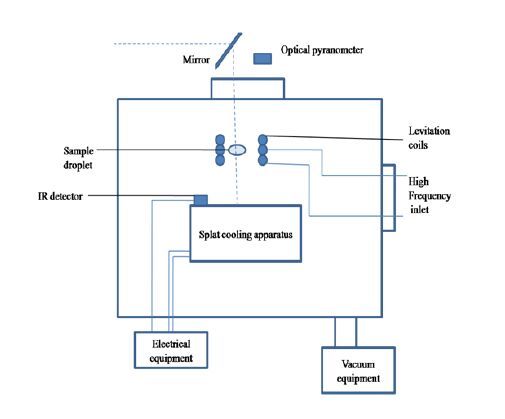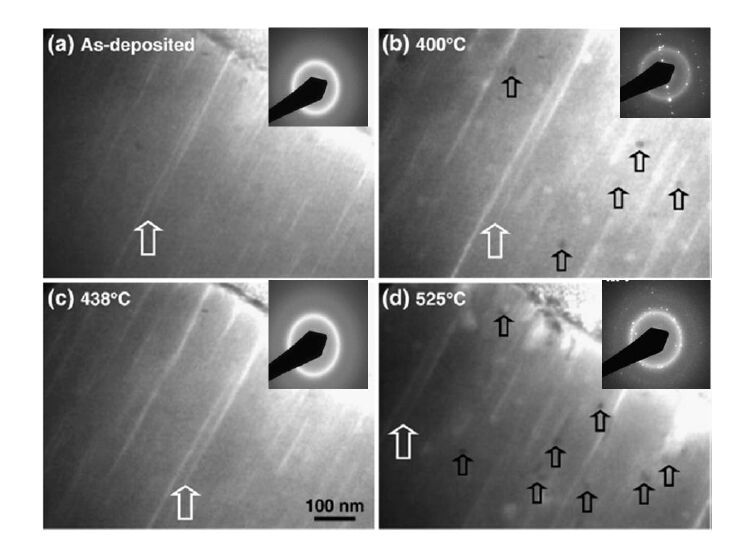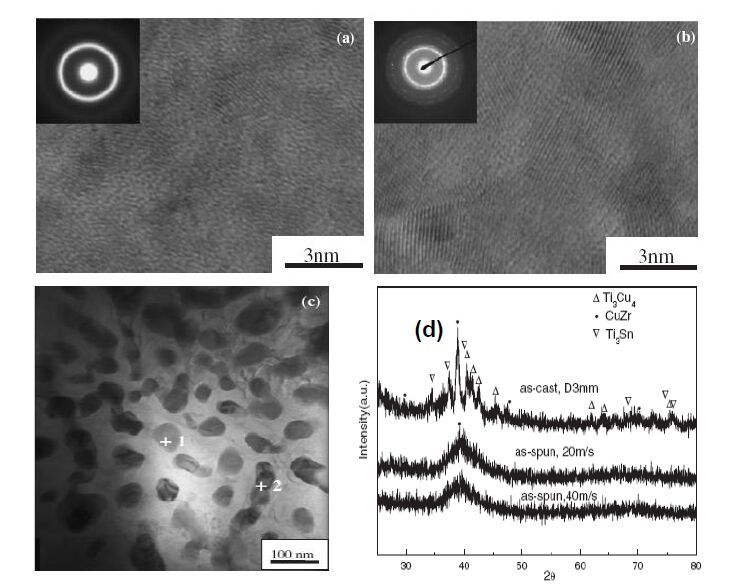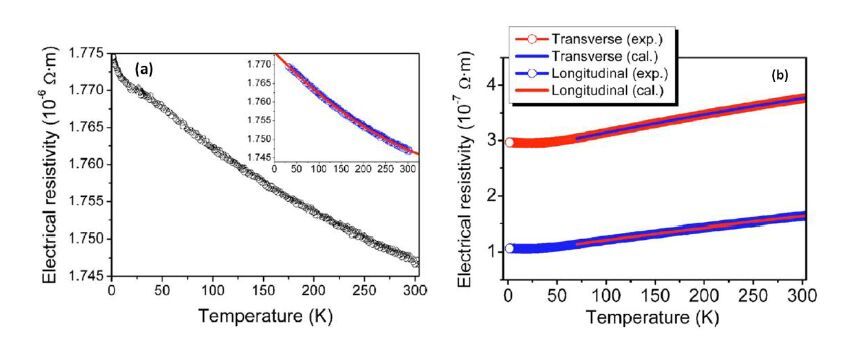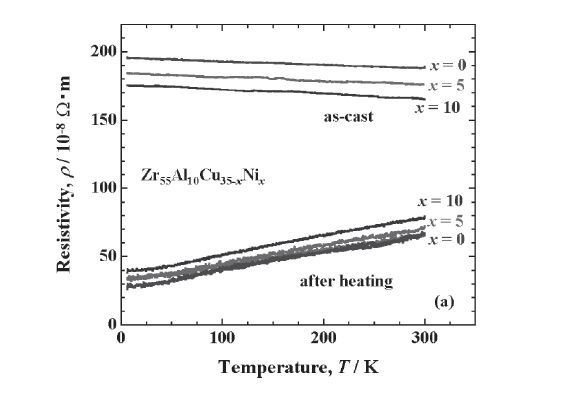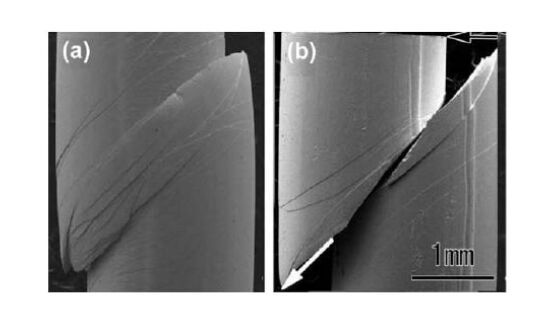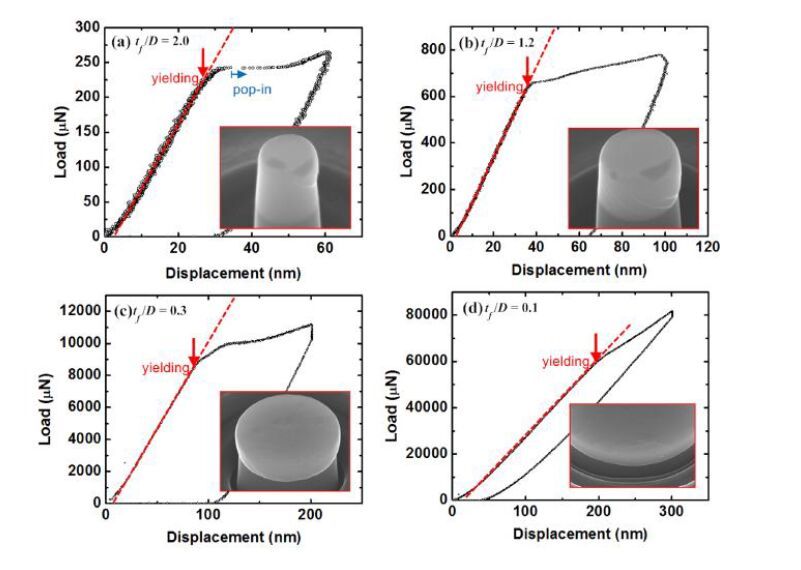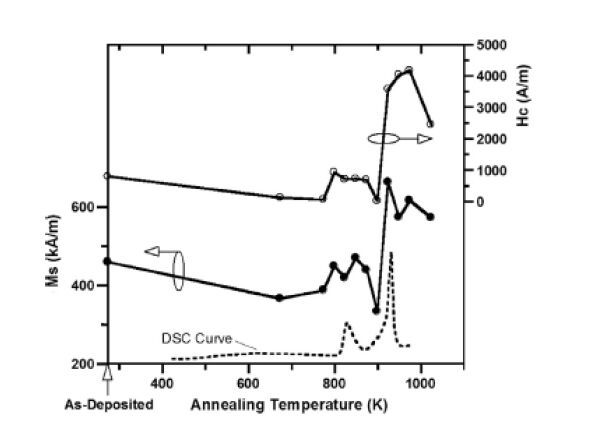Metallic glasses (MGs) are gaining immense technological significance due to their unique structure-property relationship with renewed interest in diverse field of applications including biomedical implants, commercial products, machinery parts, and micro-electro-mechanical systems (MEMS). Various processing routes have been adopted to fabricate MGs with short-range ordering which is believed to be the genesis of unique structure. Understanding the structure of these unique materials is a long-standing unsolved mystery. Unlike crystalline counterpart, the outstanding properties of metallic glasses owing to the absence of grain boundaries is reported to exhibit high hardness, excellent strength, high elastic strain, and anti-corrosion properties. The combination of these remarkable properties would significantly contribute to improvement of performance and reliability of these materials when incorporated as bio-implants. The nucleation and growth of metallic glasses is driven by thermodynamics and kinetics in non-equilibrium conditions. This comprehensive review article discusses the various attributes of metallic glasses with an aim to understand the fundamentals of relationship process-structure-property existing in such unique class of material.
1.
Introduction
Foreign exchange (FOREX) is one of the main macroeconomic indicators for determining the stability of any economy and for country-country economic and financial status comparison. It generally measures the strength of a nation's local currency compared to currency of another country that is a trading partner. For global trade in the era of open economy with increasing competitiveness, FOREX has been one of the key factors (Kartono et al., 2020). Changes in exchange rates have a substantial impact on the economy and financial markets, e.g., since oil and global commodities are traded in US dollar, fluctuations in US dollar exchange rates lead to appreciation/depreciation of local currencies. To oil exporting countries, more US dollar reserve is accrued when local currencies appreciate against the US dollar, while to the oil importing countries, more US dollars are needed to keep up with the purchase of oil from the oil producers. Similarly, the depreciation of local currencies also has a large effect on the foreign reserve of a given nation. Thus, the present study is relevant among researchers and policymakers.
Prominent US dollar exchange rates are the US dollar rates to the British pound, euro, Japanese yen, Australian dollar and Chinese yuan. These exchange rates are highly traded and exhibit high volatility due to globalization according to Anjum and Msalik (2020). The authors further stated that trading partners are manipulating their exchange rates by using quantitative easing and managed exchange rates in order to increase price competitiveness for exporters, while countries that actively manage their currency rates, such as Japan and China, adhere to open markets and flexible exchange rates. As they experience an appreciation of their local currencies, they reduce dependence on imported goods and services.
Several papers have investigated the dynamic relationship between a group of prominent exchange rates with a focus on the US dollar rate for currencies such as the euro, British pound and Japanese yen as documented in Section 2. However, no research has yet connected the volatility's long-term memory property to the actual level of asset values and checked if cointegration and dynamic connectedness have a connection econometrically. From the survey of literature, only the work of Hung et al. (2022) considered datasets similar to ours. The authors analyzed the daily US dollar exchange rates to the euro, British pound, Canadian dollar, Australian dollar, the Swiss franc and Japanese yen between January 1st to May 12th, 2021. They analyzed a variant of multivariate volatility models to investigate the equicorrelation and association between currencies.
In this paper, we investigate cointegration and dynamic connectedness in market volatility of prominent exchange rates, focusing on US dollar exchange rates to the British pound, European euro, Japanese yen, Australian dollar and Chinese yuan. We employ an updated fractional cointegration framework that relies on cointegrating vector estimates from the narrow-band frequency domain least squares (NBFDLS) estimator in obtaining the residuals from the cointegrating variable pairs. The ordinary least squares (OLS) estimator is standard, but its estimates are usually biased. The NBFDLS estimator of Christensen and Nielsen (2006) is preferred to the OLS estimator and least square estimator in the frequency domain with periodograms as in Robinson (1994a). We also consider the quantile connectedness approach to investigate extreme up (bull) and down (bear) market fluctuations in the volatility of exchange rate by considering exchange rate pairs. Specifically, we employ the quantile vector autoregressive (QVAR) framework, recently proposed by Chatziantoniou et al. (2021) to investigate the dynamic connectedness over time, across three market conditions defined as normal market, the bear market and the bull market.1 Dynamic connectedness also indicates the transmission of volatility shocks by indicating if a variable is a transmitter or a receiver of shock as indicated in the net total connectedness. Furthermore, FOREX trading portfolio management strategies are applied (see Yaya et al., 2016; Furuoka et al., 2023; Wu et al., 2023). Since the fractional cointegration is related with a quantile dynamic connectedness methodology to uncover previously unknown features of monetary relationships in this paper, the unusual combination of methodologies presented here heralds a new path for greater understanding of the interdependence of global currencies and will serve as guide to regulators and portfolio managers.
1The Quantile VAR framework of Chatziantoniou et al. (2021) is an upgrade to the generalized VAR and spillover index of Diebold and Yilmaz (2012), and Diebold and Yılmaz (2014). It measures dynamic connectedness for various quantile values 0<τ<1.
The findings in the paper are quite interesting as we observe cointegration in some pairs of exchange rates, particularly those including the euro and British pound. Furthermore, the analyses of dynamic connectedness for the three market conditions (bear, normal and bull) indicate heterogeneity in net transmission of volatility, while cases of weak average connectedness are tallied with those cases of no cointegration. FOREX pairs including the British pound, or the euro showed stronger connectedness indices compared to others. The results of portfolio management strategies show similar results to these and could serve as a guide to FOREX traders and government decision-makers.
The rest of the paper is therefore structured as follows: Section 2 presents the review of some literature. Section 3 presents the time series econometric method used in the entire paper. Section 4 presents the data, empirical results and discussion. Section 5 concludes the paper.
2.
Literature review
The study of cointegration among exchange rates is a cornerstone in comprehending the global financial market's interconnectedness and long-term equilibrium relationships. This comprehensive review of literature takes readers on a voyage through the expanding terrain of techniques and empirical evidence, giving insight on the intricacies inherent in these interconnected currency dynamics. Arize (1995) studied the impact of real exchange-rate volatility on the trade flows of Denmark, the Netherlands, Sweden and Switzerland by applying a system-based cointegration of Johansen (1991), Johansen and Juselius (1990) and multivariate error-correction model. Their findings revealed that an increase in the volatility of the real exchange rate and approximating exchange-rate uncertainty exerts a significant negative effect on export demand in both the short-run and the long-run. Using a multivariate cointegration method of Johansen (1988) and Johansen and Juselius (1990) on monthly data of US dollar/German mark (DM) exchange rates that spanned 20 years, Kim and Mo (1995) revealed that the cointegration relationship among the series of I(1) can be represented by an error-correction model. They also showed that the random walk model outperformed the monetary structural models in the short run, while monetary structural models outperformed the random walk model in the long run according to the error-correction model.
Lin et al. (1998) used a generalized linear cointegration model on the daily spot exchange rates of the US dollar against the Japanese yen, the German mark, the Singapore dollar and the Swiss franc to identify complex long-run relationships in exchange rates that might not be detectable under simple linear cointegration models. Their findings revealed that complex linear forms of cointegration could exist even where current simple linear cointegration models reveal no evidence of cointegration. Martinez (1999) investigated whether a statistical long-run relationship is observed in Mexico's balance-of-payments and exchange rate. By using a cointegration technique and innovation accounting techniques, the authors found a long-run relationship between changes in international reserves and the exchange rate and changes in domestic credit. Mexico's monetary authorities adjusted domestic assets to sterilize balance-of-payments deficits in a futile attempt to control its monetary policy. Pan and Liu (1999) found that German mark, British pound, Japanese yen, Canadian dollar, French franc, Italian lira and Swiss franc vis-a-vis the U.S. dollar are cointegrated in the usual way for a 1985–1992 sample data. The suggestion is that if there's a fractional cointegration feature within exchange rates, it is possible that this feature is not constant and could vary across different time periods. The cointegrating relationship between DM–US dollar and the yen–US dollar real exchange rates possesses long memory in terms of monetary and real factors. Only a combination of real and monetary variables can accurately track down the movements of real exchange rates (Caporale and Gil-Alana, 2004). Kang (2008) examined the cointegration relationships of foreign exchange rates of Group of Seven (G-7) countries using the Ordinary Least Squares (OLS), Maximum Likelihood Estimator (MLE) and search methods. The findings revealed bivariate cointegrations and irreducible trivariate cointegration relationships among the G-7 countries exchange rates. The search method is shown to be an effective method to find cointegration relationships. Gil-Alana and Carcel (2020) examined the cointegrating structure of British pound, the Euro, the Swedish Krona, the Canadian dollar and the Swiss Franc to the US dollar using fractional integration and fractionally cointegrated VAR by Johansen and Nielsen (2012). The findings revealed that the five exchange rates are not cointegrated in a classical way, and although they possessed long memory, the exchange rate dynamic is fractionally cointegrated.
Alessandro (2019) investigated cointegration relationships across the exchange rates of the international currencies (IC) using the Johansen cointegration test, the standard test for unit root and the augmented Dickey-Fuller test for USD/euro, and they suggested the series had a unit root in the process because the information criteria for the series considered one lag. Using volatility spillover index and LASSO-VAR approaches to examine the total and directional volatility connectedness in global foreign exchange (forex) markets, Wen and Wang (2020) found that total volatility connectedness reacts sensitively to changes in international economic fundamentals and increases during crisis periods. The authors found that oil exports, forex regimes and monetary policies are major factors driving volatility transmission across global forex markets.
Huynh et al. (2020) examined the directional spillover effects and connectedness for return and volatility of nine US dollar exchange rates of the most globally traded currencies under the influence of trade policy uncertainty. Using generalized VAR and the spillover index of Diebold and Yilmaz (2012) and Diebold and Yılmaz (2014), their findings revealed asymmetric spillovers and connectedness among the considered exchange rates when trade policy uncertainty is present and volatility spillover is stronger than the return connectedness between exchange rate and trade policy uncertainty. Gabauer (2021) used a time-varying parameter vector autoregressive framework (TVP-VAR) with a time-varying variance-covariance structure on daily exchange rate data of 15 countries to the US dollar to investigate whether countries in a currency area face symmetric shock or not. The findings revealed that the net transmitters are Austria, Belgium, Denmark, Germany, Luxembourg, France, the Netherlands, Ireland and Italy. They also revealed the existence of a small and stable optimum currency area (OCA) among Austria, Germany and the Netherlands and an extended less stable OCA, including the first OCA members and Belgium, Denmark, France and Luxembourg. Hung et al. (2022) examined the equicorrelation and causal association across major currency markets during the COVID-19 pandemic. Adopting the DECO-GARCH model developed by Engle and Kelly (2012), the transfer entropy approach and using the daily data of exchange rates of the US dollar to euro (EURO), the Canadian dollar (CAN), the British pound (GBP), the Australian dollar (AUD), the Swiss franc (CHF) and the Japanese yen (YEN), the findings revealed a bidirectional relationship between exchange rate returns. The COVID-19 outbreak triggers the spillover effects between significant exchange rates returns.
The methodology applied in the present paper is novel and has not been previously applied in all the literature listed above. Long memory cointegration test based on NBFDLS estimator is recently applied in Yaya et al. (2023) to climatological datasets, while this present paper considers long memory cointegration and quantile dynamic connectedness to investigate possible linkages.
3.
Statistical method
3.1. Fractional integration test
The standard non-seasonal I(d) is given as follows:
where d is any real number in fractional and integer values. The lag operator is L, defined such that Lxt = xt-1, while ut represents the I(0) white noise process. The left side of the difference operator in (1) is expanded using the binomial expression. Thus,
such that
and
The expansion in (2) is used for fractional differencing with a certain d value. The expression shows the dependence/correlation between xtand its lagged values xt−i, where i is a certain time in the past.
The fractional dependence parameter d has been estimated by many methods, among which are semi-parametric and parametric methods. In the frequency domain, the semi-parametric local Whittle estimation method by Robinson (1995) is a common semiparametric technique. The parametric technique uses the parametric frequency domain Whittle estimation approach (Dahlhaus, 1989), with a testing procedure of Robinson (1994b), which is a Lagrange multiplier (LM) principle, using the null hypothesis,
provided d0 are real values. Robinson (1994b) extended (1) using the linear deterministic function as in the augmented Dickey-Fuller (ADF) regression. Thus, (1) becomes (4) below,
where β0 and β1 are the intercept and slope parameters, respectively, for trend t in the model. The significance of β1 in the entire estimation process informs the relevance/preference of the deterministic term over others. By respecifying the two equations in (4) as a single one, we have
where y∗t=(1−L)doyt; 1∗t=(1−L)do1t; t∗t=(1−L)dott. With the fact that ut is still an I(0) process by construction, we can then estimate β0 and β1 in (5) by standard OLS methods, such that the estimated residuals are
For robustness, the results of fractional integration obtained using the parametric approach of Robinson (1994b) are supported with those obtained using the semiparametric method of Robinson (1995). The attractiveness of the semi-parametric methods is that no validation of assumption on the error term is required. The local Whittle (LW) estimator in the frequency domain is employed, and this uses a frequency band that degenerates to zero. This method is proposed by Robinson (1995), and it uses the estimator,
where d∈(−12,12)and
¯C(d)=1m∑mj=1I(λj)λ2dj;λj=2πjT,1m+1T→0,
where m stands for the parameter of bandwidth, while I(λj) is the periodogram of the time series, xt specified as
Robinson (1995) showed that under the finiteness of the fourth moment and other very mild conditions,
with the actual value of d, represented by d0.
3.2. Homogeneity of paired fractional integration order test
The homogeneity test of paired integration orders by Robinson and Yajima (2002) is necessary in the case of fractional differencing, while Engle and Granger (1987) have relaxed the unit differencing condition to be of any real number. This makes the extension to fractional cointegration easier. Thus, equality of fractional order needs to be established by testing for non-significance differences in the distribution of the differencing order based on the null,
where dy1 and dy2 are the two integration orders from the paired series (y1t,y2t). The test statistic is given as
where h(T)>0 and ˆG2y1,y2 represents the (y1×y2)th element of ˆΛ(λj)−1I(λj)ˆΛ(λj) with ˆΛ(λj)=diag{eiπˆdy1/2λ−ˆdy1,eiπˆdy2/2λ−ˆdy2}. The test is normally distributed with a two-sided critical value of approximately 1.96. Thus, once equality of fractional integration orders is reached, a fractional cointegration test is carried out; this is described in the next sub-section.
3.3. Narrow-band frequency domain least square approach
The narrow band frequency domain least square (NBFDLS) must estimate be considered to obtain the cointegrating vector linking the paired variables provided that the variables possess long memory properties with weakly dependent regressors. Thus, the regressors and the residuals are correlated, even over a long-time span. The NBFDLS is a semi-parametric estimator that applies the OLS on a degenerated band of frequencies around the origin, as proposed in Robinson (1994a), with further modification and current software implementation in Christensen and Nielsen (2006) for stationary time series.
In the two-variable case, i.e., y1t and y2t for fractional integration orders (0<d<0.5) and residuals of order de<d, the NBFDLS estimator can be written as
which as m approaches infinity, tends to be distributed as,
where gy1 and ge are the 2×2G diagonal matrix elements. It can be seen from (10), that as long as d+de<0.5, normality is always ensured (see Christensen and Nielsen, 2006).
3.4. The quantile-VAR framework
The strength and transmission of volatility shocks between the two return variables y1t and y2t being investigated is known as the connectedness analysis. The quantile vector autoregressive (QVAR) dynamic connectedness method was proposed by Chatziantoniou et al. (2021). In light of this, the connectedness between the paired exchange rates for the 5th (lower) quantile, 50th (median) quantile and 95th (upper) quantile are investigated. The approach uses the estimate of the quantile VAR(p) model defined using quantile, τ:
where the Xt is the vector of 2×1 dimensional endogenous variables Xt = (y1t, y2t) and τ is the quantile with values ranging between 0 and 1 towards the 5th quantile and 95th quantile, respectively. The 50th quantile (τ = 0.50) explains the normal market condition, and the bearish and bullish market conditions are found at the lower (τ=0.05) and upper (τ=0.95), respectively. Then, p gives the order of the quantile VAR model as shown in (12). The conditional mean vector of 2×1 is represented by μ(τ), the 2×2 dimensional autoregressive model coefficient matrix is denoted by Φj(τ), the 2×1 dimensional error vector with a 2×2 dimensional variance-covariance matrix ∑(τ),denoted by ut(τ). Using the world's representation, the QVAR(p) is converted to a quantile vector moving average [QVMA(∞)} thus:
where Ψi is the 2×2 dimensional matrix of moving average coefficients and ut−i are the moving average innovations. This is approach is suggested by Koop et al. (1996) and Pesaran and Shin (1998) and is necessary for determining the connectedness between any two markets in terms of returns and variance. It is the H-step ahead generalized forecast error variance decomposition (GFEVD) given as,
which transforms to
where ei in (14) represents a zero vector which equals unity on the ith position, which also results in two equalities in (15), i.e., ∑kj=1˜Ψτij(H)=1 and ∑ki,j=1˜Ψτij(H)=k. The influence of variable j on another variable i in terms of its share of forecast error variance/shocks is being measured by ˜Ψτij(H), and this is defined as the total directional connectedness to others, that is, Cgi←j(H), which is the directional volatility spillovers from j to i. Also, the influence received by variable j from another variable i, which is the total directional connectedness FROM others is computed as Cgi→j(H) which is the directional volatility spillover from i to j. The net directional connectedness is then calculated as
If NETτ is greater than 0, it means variance shock in that variable influences the second variable more than it is being influenced, but if NETτ is less than 0, this implies that the variable is being dominated by the other variable in terms of variance shock. Thus, in cases where NETτ>0, the variable is a net transmitter of shocks, while in cases where NETτ<0, the variable is a net receiver of shock. The total connectedness index (TCI) between variables i and j is given in (16) and can be expressed as:
where this gives the strength of the connectedness in the paired variables. If the TCI is high, it means high market risk between the two assets and they influence each other more strongly, but if it is low, it means low market risk, as the two assets influence each other weakly.
4.
Data, results, and discussion
Daily US dollar exchange rates to the Australian dollar (AUD), Chinese yuan (CNY), European euro (EUR), British pound (GBP) and Japanese yen (JPY) were used in this study. The data spanned May 16, 2006, to August 10, 2022, and were retrieved from the Yahoo Finance website (https://www.finance.yahoo.com). The descriptive statistics are presented in Table 1. We observed a noticeable variation in the exchange rate of the Japanese yen. Other exchange rates appear to be distributed normally, having approximately equal mean and median values. Plots of these exchange rates are given in Figure 1, along with each corresponding log-returns since the focus is on volatility, which is visible with the log-returns plot. For USD/AUD, USD/EUR, USD/GBP and USD/JPY, we observe a general decreasing trend over the historical years. This implies that the local currencies, the Australian dollar, euro, British pound, and Japanese yen have appreciated against the US dollar over the years. The only exception is USD/CNY, in which the Chinese yuan has depreciated against the US dollar over the years. A closer look at the log-returns plot indicates possible higher volatility in the case of USD/AUD, USD/CNY and USD/GBP exchange rates, which explains that those FOREX markets are more turbulent than the remaining markets (USD/EUR and USD/JPY).
Table 2 presents the results of volatility persistence in the three FOREX markets. The log returns have been transformed into absolute returns used as a proxy for volatility here. Estimates of fractional integration are obtained from the absolute return series, based on Robinson's (1994b) framework. The selected model results are in bold for each exchange rate series. It is observed that USD/EUR and USD/JPY exchange rates present higher volatility persistence compared to USD/GBP, USD/AUD and USD/CNY, even though all these persistence are around 0.2. By linking these results with the observation in Figure 1, it means that USD/AUD, USD/CNY and USD/GBP exchange rates with higher volatility will persist less as the results revealed in Table 2. In addition, these volatilities are in a long memory range and external shocks targeted to them will be transitory.
Next, in Table 3, we conducted homogeneity of fractional integration orders for the pairs following from the results of Robinson (1994b) in Table 2. Since we have included five US dollar exchange rate variables, these lead to 10 variable pairs as reported in Table 3.2 The t-statistics for the homogeneity test of Robinson and Yajima (2002) are reported in the table where no rejection of null hypotheses of equality of fractional orders for any pair of variables is observed.
2Note, GBP is the USD/GBP exchange rate, EUR is the USD/EUR exchange rate and similarly to the remaining eight exchange rates.
Since our interest is on the behaviour of volatility pairs of the exchange rate, and with the notion of volatility series (absolute returns or square returns of asset prices) portraying long memory properties in which 0<d<0.5, we relied on an updated fractional cointegration beta estimator. The NBFDLS estimator is robust to testing fractional cointegration within the long memory range. The estimator uses bandwidth numbers mto obtain the residuals from the cointegrating vector of the variable pairs. This estimator relied on its β values for obtaining the residuals e as e=y2t−βy1t, where the paired series are (y1t,y2t). These β values are reported in Table 4 for the bandwidths m=T0.5 and T0.6. Estimates of residuals for cointegration obtained in this way using the NBFDLS estimator of Christensen and Nielsen (2006) are preferred to the standard OLS residuals for cointegration (see Yaya et al., 2023).
Then, the residual series e was estimated for fractional cointegration using Marinucci and Robinson (2001). The residual-based cointegration test uses the residuals e from the NBFDLS β values. For the cointegration of any pair, it was expected that the fractional difference value for a residual series, de<min(dy1,dy2) where dy1 and dy2 are the two integration orders from the paired series (y1t,y2t). In Table 5, we found no case of anti-persistence (−0.5<d<0) but all estimates of fractional orders for residuals are in the long memory range, with an upper bound limit of estimates quite below 0.3 in the two frequency bandwidths.
Table 6 summarized the results in Table 2 and Table 5, where the results in Table 2 have been paired and reported in the second column y1t- y2t of Table 6 and the cases where the fractional cointegration condition de<min(dy1,dy2) are satisfied as indicated. The results showed seven pairs indicating fractional cointegration: GBP – EUR, GBP – JPY, GBP – AUD, GBP – CNY, EUR – JPY, EUR – AUD and JPY – AUD.
The next research question is how strong are these comovements? Which exchange rate dominates the other in terms of volatility? The results of quantile dynamic connectedness are presented for the middle quantile (Table 7), lower quantile (Table 8), and upper quantile (Table 9). In the case of the middle quantile (normal market condition) in Table 7, the average total connectedness indices (TCIs) are generally low with the highest in this table being 27.88 in the case of the GBP – EUR pair. This agrees with the notion emanating from the cointegration results that USD/GBP and USD/EUR drive other exchange rates. The least in terms of connectedness is JPY – CNY pair with 6.00 TCI–this pair is not indicating cointegration–and the pair AUD – CNY with 6.20 TCI. At this middle quantile, GBP is a net transmitter of a shock to EUR, JPY and CNY markets, while EUR is a net transmitter of a shock to JPY and CNY markets. These results are generally heterogenous, possibly due to low TCIs observed during this market phase.
In Table 8, At the lower quantile, which is the bear market state, the average connectedness index (TCI) is higher compared to that of the normal market state. Thus, exchange rates are more strongly bounded in pairs. The GBP – EUR pair has a TCI of 63.72, GBP – AUD has a TCI of 64.00, EUR – JPY has a TCI of 60.01, EUR – AUD has a TCI of 63.28, while GBP – JPY pair has a TCI of 53.69, GBP – CNY has a TCI of 39.55 and EUR – CNY has a TCI of 39.69. Thus, the US dollar/British pound and the US dollar/euro form pairs with those US dollar exchange rates with TCI above 60. Also, in the bear market, the performance of the US dollar/British pound (GBP) and US dollar/euro are heterogeneous in terms of volatility spillovers.
At the bull market state (see Table 9), the average TCI increased, with at least 80.0 in each pair and the highest TCI was 85.63 for the GBP – AUD pair. Generally, the pairs involving GBP and EUR still present higher TCIs compared to pairs of other exchange rates not involving GBP and EUR. By relating these results of average TCI with that of cointegration, one can say that there is a connection between long-memory cointegration and dynamic connectedness. In terms of transmission of volatility, heterogeneity is also observed at the bull FOREX market phase. It is only in GBP – CNY pair that we observed homogeneity in the net transmission of volatility that the normal market, bear and bull market phases, where the US dollar/British pound (GBP) is consistently the net transmitter of volatility shock and US dollar/Chinese yuan (CNY) is consistently the net shock receiver.
4.1. Bivariate portfolios investment strategy
It follows to investigate portfolio strategies necessary to be adopted by portfolio managers to maintain or maximize profits by minimizing risks encountered on daily basis. Antonakakis et al. (2020) have suggested using estimates of time-varying variance-covariances and time-varying conditional correlations from the DCC-GARCH-t-Copula model to obtain the dynamic portfolio weights of Kroner and Ng (1998) and hedge ratios of Kroner and Sultan (1993). Kroner and Ng (1998) suggested the measure,
with wijt={0,wijt,1,if wijt<0 if 0⩽wijt⩽1if wijt>1, where wijt is the weight of FOREX i in a $1 portfolio of the two FOREX (i,j) at time t, which leaves the proportional weight of FOREX j in the same portfolio as wjit=(1−wijt), hjjt and hiit denote the conditional variance series from the volatility model of each asset and hijt is the corresponding covariance series at a time, t. In the case of USD-GBP and USD-CNY exchange rate pairs, the weight of USD-GBP FOREX in the $1 priced portfolio of the two assets is wgbp,cny,t, which leaves the corresponding weight of USD-CNY FOREX at 1−wgbp,cny,t. Another portfolio management strategy by Kroner and Sultan (1993) on risk-minimizing hedge ratio is given as,
where a low hedge ratio βijt between the two FOREX assets (i,j) suggests that the risk in FOREX i can be hedged by taking a short position in FOREX j markets. Similar to optimal portfolio weight in the case of the USD-GBP and USD-CNY pair above, the hedge ratio measure βgbp,cny,t implies that the risk at the USD-GBP exchange rate market can be hedged by taking a short position in the USD-CNY exchange rate market.
In Table 10, the results of average optimal weights (wijt) and hedge ratios (βijt) obtained are presented in the second column and the third column of the table, respectively. By looking at the optimal weights in a $1 portfolio worth of FOREX containing the British pound (GBP) and Australian dollar (AUD), about 73 cents of the British pound should be invested, which corresponds to about 27 cents of the Australian dollar. In portfolio pairs containing Chinese yuan with other currencies such as the Australian dollar, euro, British pound, and Japanese yen, it is observed that more than 90 cents of Chinese yuan are required to be invested as against about 10 cents remaining for the other paired currency in the portfolio to maintain the accrued profits over time. These are portfolio pairs with weaker dynamic connectedness reported earlier in this paper. Thus, FOREX portfolio weighting relates to dynamic connectedness.
Results of the hedge ratio in the last column of Table 10 are striking also as we observe that those portfolio pairs containing Chinese yuan with other currencies such as the Australian dollar, euro, British pound, and Japanese yen require 3–7% of the other currencies in pairs with Chinese yuan to shorten $1 long of those FOREX traded with the Chinese yuan.
5.
Conclusions
In this study, we focus on US dollar exchange rates to the British pound, European euro, Japanese yen, Australian dollar, and Chinese yuan to simultaneously investigate cointegration and dynamic connectedness in markets volatility of prominent currency rate pairs. We employed an updated fractional cointegrating framework, that is the narrow-band frequency domain least squares estimator of Christensen and Nielsen (2006) for obtaining residual series from cointegrating vector pairs. This estimator is preferred to the classical least square estimator and the least square in the frequency domain with periodograms, as in Robinson (1994a), because it allows fractional cointegration in long memory range. Quantile connectedness technique was used to examine the volatility of exchange rate pairs for extreme bull and bear market movements and at the normal market condition. Thus, investigating both cointegration and dynamic connectedness in a unified framework in this paper is an attractiveness, even the quantile analyses which make the presentation extremely different from Hung et al. (2022).
We first found that seven paired cases, i.e., GBP-EUR, GBP-JPY, GBP-AUD, GBP-CNY, EUR-JPY, EUR-AUD and JPY-AUD, satisfied the fractional cointegration criterion based on the narrow-band frequency domain least squares estimator for cointegrating betas. Quantile connectedness results showed that the pairs that indicated cointegration coincided with cases of stronger connectedness at the normal market, bear, and the bull market condition. One can infer that the long-memory cointegration and dynamic connectedness are related based on the findings. Furthermore, during the three market conditions analyzed by quantiles, the transmission or receipt of volatility shocks is unaffected by market situations. The outcomes of the developed portfolio management strategies likewise agree with those of cointegration and quantile connectedness.
This work is therefore seen as a fresh extension to Hung et al. (2022) because our findings agree with those of the authors in the paper. Our findings will interest FOREX traders, government, and policymakers. This work is opened to scrutiny, and it can also be extended to other low-volume traded US dollar exchange rates using daily and tick-by-tick datasets.
Use of AI tools declaration
The authors affirm that no artificial intelligence (AI) tools are used in the creation of this work.
Acknowledgments
The authors thank the editor and the three anonymous reviewers for their valuable suggestions that led to the success of this research work.
Funding
The authors have received no funding from any source in the preparation of this work.
Conflict of interest
The author declares no conflicts of interest in this paper.









 DownLoad:
DownLoad:



